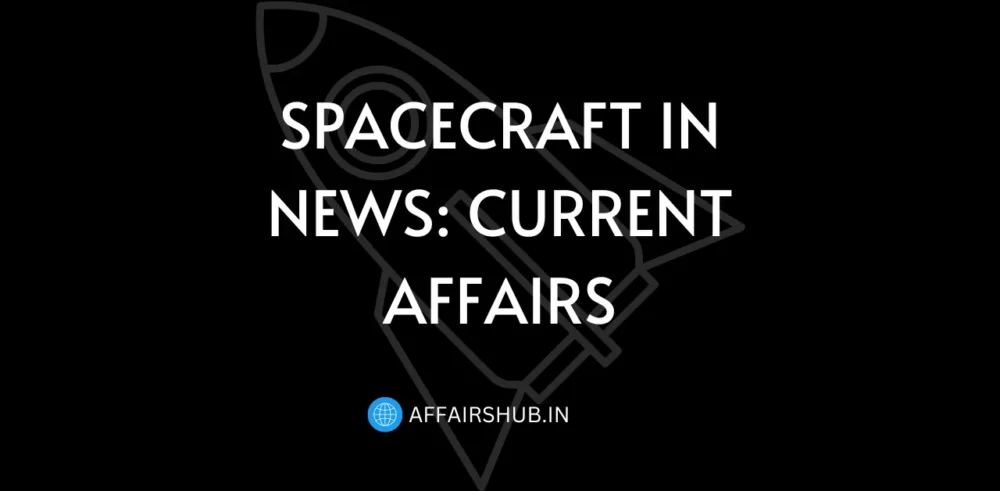The Aditya-L1 mission is an ambitious venture by India in the field of solar exploration, with a focus on uncovering the enigmas surrounding our nearest star, the Sun. The launch date for this mission is set for September 2, showcasing India’s advancing capabilities in space technology. With an anticipated budget of Rs 400cr, Aditya-L1 is geared towards accomplishing various scientific goals and will transport a range of advanced payloads into outer space.
Here is in-depth information about India’s inaugural solar observatory, Aditya-L1 Mission.
Aditya -L1 Full Form
“Aditya” is a synonym for Sun in Sanskrit and Hindi. It is a fitting name for the Aditya-L1 mission, the first Indian solar mission to study the Sun. Here, the “L1” stands for Lagrangian point 1 (L1), a gravitationally stable point between the Sun and the Earth. The Aditya-L1 spacecraft will be placed in a halo orbit around the L1 point, where it will be able to study the Sun from a safe distance.
✅ Read Also: Spacecraft in News: Latest Science and Tech Current Affairs
Aditya-L1 Mission Overview
The table overviews India’s first Solar Mission, Aditya L1. The mission will be launched from the Satish Dhawan Space Centre (SDSC) in Sriharikota, Andhra Pradesh, India.
| Aditya-L1 Mission Overview | |
|---|---|
| Mission type | Solar Observation |
| Launch date | September 2, 2023 |
| Launch Time | 11:50 IST (6:20 UTC) (planned) |
| Launch Vehicle | PSLV-XL(C57) |
| Orbit | Halo orbit around the Sun-Earth Lagrange point 1 (L1) |
| Time to reach the halo orbit around the L1 point | 109 Earth days |
| Mission Duration | 5.2 years |
| Mission objective | Study the Sun’s atmosphere, including the corona, chromosphere, and photosphere |
| Payloads | 7, including a visible emission line coronagraph, a solar ultraviolet imaging telescope, and a solar low energy X-ray spectrometer |
| Launch mass | 1,475 kg (3,252 lb) |
| Payload mass | 244 kg (538 lb) |
| Launch center | Satish Dhawan Space Centre (SDSC) SHAR, Sriharikota, India |
| Budget | ₹400 crores (US$53 million) |
What is Aditya-L1 Mission of ISRO
Aditya-L1 Mission is India’s First Solar Observatory mission launched by the Indian Space Research Organisation (ISRO).
The mission’s name, Aditya, is derived from the Sanskrit word for “Sun.” Aditya is a forthcoming spacecraft dedicated to coronagraphy.
This cutting-edge project is a collaborative effort between the Indian Space Research Organisation (ISRO) and various Indian research institutes.
Aditya-L1’s mission is to explore the solar atmosphere, examining solar magnetic storms and their effects on the Earth’s environment.
Aditya’s spacecraft will be placed in a halo orbit around the L1 Lagrange point, about 1.5 million kilometres from Earth.
From this vantage point, Aditya-L1 will be able to study the Sun’s atmosphere in unprecedented detail.
The mission is expected to provide valuable insights into the Sun’s behaviour and impact on Earth.
KEY POINTS `````````````````` ☛ Aditya-L1 is India's first dedicated solar mission. ☛ The Aditya spacecraft will be placed in a halo orbit around the L1 Lagrange point. ☛ The L1 Lagrange point is located about 1.5 million kilometers from Earth. ☛ From this vantage point, Aditya-L1 will be able to study the Sun's atmosphere in unprecedented detail. ☛ The mission is expected to provide valuable insights into the Sun's behavior and its impact on Earth.

Aditya-L1 Mission Launch Date
The launch of Aditya-L1 is scheduled for September 2, 2023, aboard a PSLV-XL launch vehicle, paving the way for groundbreaking solar research.
✅ Read Also: Satellite in News, Latest Science & Technology Current Affairs
What is Coronagraphy?
In the case of the Sun, coronagraphy is used to study the solar corona, which is the hot, tenuous outer atmosphere of the Sun.
The corona is much lighter than the Sun’s surface, making it difficult to see directly. Coronagraphs use various techniques to block out the Sun’s light, such as occulting disks, phase masks, and adaptive optics.
Coronagraphy has been used to study various phenomena in the solar corona, including solar flares, coronal mass ejections, and prominences.
It has also been used to search for planets around other stars.
Benefits of Coronagraphy
- It allows us to study the solar corona, otherwise hidden by the Sun’s bright light.
- It can be used to search for planets around other stars.
- It can be used to study solar flares, coronal mass ejections, and prominences.
Challenges of Coronagraphy
- It is a very difficult technique to use.
- It requires very sensitive instruments.
- It can be affected by atmospheric turbulence.
Despite the challenges, coronagraphy is a powerful tool for studying the Sun and other stars. It has helped us to learn a great deal about these objects and their environments.
Aditya-L1 Mission History
Back in January 2008, the Advisory Committee for Space Research initiated the idea of Aditya, though some questioned its feasibility.
Initially, it was envisioned as a modest 400 kg (880 lb) satellite orbiting in Low Earth Orbit (LEO) at 800 km altitude.
Its primary mission was to explore the solar corona, equipped with a coronagraph.
Aditya-L1 Mission Cost or Budget
The Aditya L1 mission is a flagship project by the Indian Space Research Organisation (ISRO). Its estimated budget is approximately ₹378.53 crore (US$49 million), excluding launch expenses.
This budget encompasses all aspects of the mission, covering spacecraft design, development, launch, and mission operations.
It also factors in the expenses related to the advanced instrumentation and expertise essential for studying the Sun’s corona.
The budget is expected to increase slightly to accommodate unforeseen circumstances, operational requirements, and post-launch activities, reaching around ₹400 crore (US$50 million).
This financial commitment underscores India’s dedication to advancing its space capabilities and contributing to global scientific advancements.
Aditya L1 Launch Vehicle
The Aditya L1 mission will be launched by the Polar Satellite Launch Vehicle (PSLV) XL. The PSLV is a four-stage rocket that is capable of launching satellites into low Earth orbit, geosynchronous transfer orbit, and geostationary orbit.
The PSLV XL is an enhanced version of the PSLV that is capable of launching heavier payloads. It will be used to launch the Aditya L1 spacecraft into a halo orbit around the Lagrangian point 1 (L1) of the Sun-Earth system.
The PSLV XL is a reliable launch vehicle with a long history of success. It has been used to launch over 300 satellites into orbit, including the Chandrayaan-1 and Mangalyaan missions. The PSLV XL is expected to successfully launch the Aditya L1 mission.
Here are some of the specifications of the PSLV XL:
- Length: 44 m (144 ft)
- Diameter: 2.8 m (9 ft 2 in)
- Mass: 320 tonnes
- Stages: 4
- Thrust: 4,830 kN
- Payload Capacity: 1,800 kg (4,000 lb) to Sun-synchronous Orbit
- First Flight: September 20, 1993
What is Lagrange Point 1?
Lagrange Point 1, often denoted as L1, is a point in space between a celestial body, such as the Earth, and the body it orbits, in this case, the Sun.
It is one of the five Lagrange points in the Earth-Sun system.
Its unique gravitational properties make it a valuable location for space missions, such as ISRO’s Aditya-L1 mission.

At L1, the gravitational forces of the Earth and the Sun balance in such a way that objects placed there can effectively “hover” relative to the Earth’s and the Sun’s positions.
This allows spacecraft at L1 to maintain a relatively stable position relative to the Earth as they orbit the Sun, providing an unobstructed view of the Sun for extended periods.
In the case of the Aditya-L1 mission, positioning the spacecraft at Lagrange Point 1 enables it to continuously observe and study the Sun without being affected by the Earth’s atmosphere or orbit.
This offers a unique vantage point for solar observations and research, making it an ideal location for a solar and space environment observatory like Aditya-L1.
Aditya L-1 Mission Objectives
☛ To Study Solar upper atmospheric (chromosphere and corona) dynamics
The Aditya L1 mission will study the dynamics of the Sun’s upper atmosphere, including the chromosphere and corona.
This will help scientists, to understand how these layers of the Sun are heated and how they interact with each other.
☛ To Study chromospheric and coronal heating, physics of the partially ionised plasma, initiation of the coronal mass ejections, and flares
The Aditya L1 mission will study the physics of the Sun’s chromosphere and corona, including how they are heated and produce solar flares and coronal mass ejections (CMEs).
This will help scientists to understand the mechanisms that drive these solar events and their impact on Earth.
☛ To Observe the in-situ particle and plasma environment providing data for the study of particle dynamics from the Sun
The Aditya L1 mission will observe the in-situ particle and plasma environment around the Sun. This will provide data on the dynamics of these particles and how they interact with the Sun’s atmosphere.
☛ To Study the Physics of the Solar Corona and its heating mechanism
The Aditya L1 mission will study the physics of the solar corona and its heating mechanism. This is a major unsolved problem in solar physics, and the Aditya L1 mission will help scientists make progress in understanding it.
☛ To Diagnostics of the coronal and coronal loop plasma: Temperature, velocity, and density
The Aditya L1 mission will diagnose the properties of the coronal and coronal loop plasma, including its temperature, velocity, and density.
This will help scientists to understand the dynamics of these plasmas and how they interact with each other.
☛ To Study the Development, dynamics, and origin of CMEs (Coronal Mass Ejections (CMEs))
The Aditya L1 mission will study the development, dynamics, and origin of CMEs.
This will help scientists understand how the events of CMEs are triggered and how they propagate through the solar system.
☛ To Identify the sequence of processes that occur at multiple layers (chromosphere, base, and extended corona) that eventually lead to solar eruptive events
The Aditya L1 mission will identify the sequence of processes that occur at multiple layers of the Sun (chromosphere, base, and extended corona) that eventually lead to solar eruptive events.
This will help scientists understand the chain of events that led to these events and their impact on Earth.
☛ To Study the Magnetic Field Topology and magnetic field measurements in the Solar Corona
The Aditya L1 mission will study the solar corona’s magnetic field topology and magnetic field measurements.
This will help scientists understand how the Sun’s magnetic field is generated and how it interacts with the Sun’s atmosphere.
☛ To Study the Drivers for Space Weather (origin, composition, and dynamics of the solar wind:
The Aditya L1 mission will study the drivers for space weather, including:
- Origin of the solar wind
- Composition of the solar wind
- Dynamics of the solar wind.
This will help scientists to understand how space weather is generated and how it can impact Earth.
What Payloads Will It Carry?
The Aditya-L1 spacecraft is equipped with seven specialized payloads.
These payloads are designed to investigate various aspects of the Sun, including the photosphere, chromosphere, and the outermost layer, the corona.
These payloads utilize electromagnetic, particle, and magnetic field detectors.
Notably, four of these payloads have a unique vantage point, directly observing the Sun, while the remaining three conduct in-situ studies of particles and fields at the L1 position.
This positioning enables vital scientific research on the influence of solar dynamics in the interplanetary medium.
Aditya-L1’s payloads are expected to yield crucial insights into key phenomena such as coronal heating, coronal mass ejections, pre-flare and flare activities, as well as the dynamics of space weather, and the propagation of particles and fields.
These findings are integral to advancing our understanding of the Sun’s behaviour and its impact on our space environment.
List of Payloads Carried by Aditya L-1
☛ Visible Emission Line Coronagraph (VELC) for Corona imaging & spectroscopy studies.
☛ Solar Ultraviolet Imaging Telescope (SUIT) for Photosphere and Chromosphere imaging (narrow & broadband)
☛ Solar Low Energy X-ray Spectrometer (SoLEXS) for soft X-ray spectrometer: Sun-as-a-star observation
☛ High Energy L1 Orbiting X-ray Spectrometer(HEL1OS) for hard X-ray spectrometer: Sun-as-a-star observation
☛ Aditya Solar Wind Particle Experiment(ASPEX) for solar wind can do particle analysis
☛ Plasma Analyser Package For Aditya (PAPA) for Solar wind; can do particle analysis
☛ Advanced Tri-axial High-Resolution Digital Magnetometers for in-situ magnetic field studies
Types of Payloads Along with Their Major Capability of Scientific Investigation
Source: ISRO Official Website
| Type | Sl. No. | Payload | Capability |
|---|---|---|---|
| Remote Sensing Payloads | 1 | Visible Emission Line Coronagraph(VELC) | Corona/Imaging & Spectroscopy |
| 2 | Solar Ultraviolet Imaging Telescope (SUIT) | Photosphere and Chromosphere Imaging- Narrow & Broadband | |
| 3 | Solar Low Energy X-ray Spectrometer (SoLEXS) | Soft X-ray spectrometer: Sun-as-a-star observation | |
| 4 | High Energy L1 Orbiting X-ray Spectrometer(HEL1OS) | Hard X-ray spectrometer: Sun-as-a-star observation | |
| In-situ Payloads | |||
| 5 | Solar wind/Particle Analyzer Electrons and heavier Ions with directions | Solar wind/Particle Analyzer Protons & Heavier Ions with directions | |
| 6 | Plasma Analyser Package For Aditya (PAPA) | Advanced Tri-axial High-Resolution Digital Magnetometers | |
| 7 | Solar wind/Particle Analyzer Protons and heavier Ions with directions | In-situ magnetic field (Bx, By and Bz). |
Frequently Asked Questions
Aditya L1 is scheduled to be launched on September 2, 2023, at 11:50 AM IST from the Satish Dhawan Space Centre in Sriharikota, India.
The European Space Agency (ESA) is set to track the ISRO’s Aditya-L1 and Chandrayaan-3 satellites. The ESA will use its ground stations to do so and provide the ISRO with data.
The Aditya L1 mission is a solar mission of the Indian Space Research Organisation (ISRO). It is the first space-based observatory-class Indian solar mission to study the Sun. The spacecraft is planned to be placed in a halo orbit around the Lagrangian point 1 (L1) of the Sun-Earth system, which is about 1.5 million km from the Earth.
L1 stands for Lagrangian point 1. It is a gravitationally stable point between the Sun and the Earth. The Aditya-L1 spacecraft will be placed in a halo orbit around the L1 point, where it will be able to study the Sun from a safe distance.
India has planned the Aditya L1 mission to study the Sun. The mission is being carried out by the Indian Space Research Organisation (ISRO).
The launch vehicle of the Aditya L1 mission is PSLV-XL(C57).
The Aditya-L1 mission was started to study the Sun in detail. The mission will help scientists understand the Sun’s atmosphere, magnetic field, and activity. The mission will also help scientists understand the causes of solar flares and coronal mass ejections, which can significantly impact Earth’s climate and space weather.
Aditya-L1 Support Cell (AL1SC), a joint effort of ISRO and ARIES, is set up at ARIES’s transit campus in Haldwani, Uttarakhand.









